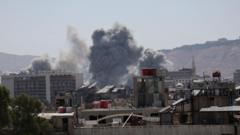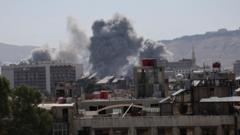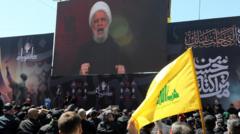With the Assad regime's reign ended, rebel forces are stepping up efforts to manage a fractured nation, while addressing both celebratory and ominous signs of lawlessness.**
Turmoil and Transition: Syrian Rebels Seize Control of Damascus**

Turmoil and Transition: Syrian Rebels Seize Control of Damascus**
Amidst the chaos following the fall of Assad, Syrian rebels scramble to establish a new government.**
As Syrian rebels celebrated their recent takeover of Damascus, they declared the formation of a new government poised to address the immediate challenges facing the beleaguered nation. The abrupt downfall of President Bashar al-Assad has left millions of Syrians grappling with the shocking turn of events, while the international community watches with a mixture of hope and caution.
Reports from the capital revealed a stark environment where abandoned military tanks and vacant checkpoints serve as haunting reminders of the regime that once ruled with an iron fist. As the dust settles, early signs of disorder emerge, exemplified by vandalized shops and broken vehicle windows, inciting fears of potential chaos. However, many citizens also exhibited joy, reveling in the liberation from a tyrannical leader.
In an exclusive interview, Alissa Rubin, a senior Middle East correspondent, elaborated on the regional dynamics that culminated in the Assad regime's collapse. The shift is largely attributed to a diminished Hezbollah presence in Syria, a result of intensified Israeli actions, coupled with Russia's distraction due to different commitments. Such international factors play a crucial role in shaping both the current landscape and Syria’s future.
As the newly empowered rebels navigate the complex web of the nation’s ethnic and sectarian divides, they face monumental tasks ahead. The challenges of ensuring security and governance loom large, raising pressing questions regarding the path toward stability and rebuilding trust among the diverse population. Syria finds itself at a crossroads, with uncertainties tinged with hope for a brighter tomorrow.
Reports from the capital revealed a stark environment where abandoned military tanks and vacant checkpoints serve as haunting reminders of the regime that once ruled with an iron fist. As the dust settles, early signs of disorder emerge, exemplified by vandalized shops and broken vehicle windows, inciting fears of potential chaos. However, many citizens also exhibited joy, reveling in the liberation from a tyrannical leader.
In an exclusive interview, Alissa Rubin, a senior Middle East correspondent, elaborated on the regional dynamics that culminated in the Assad regime's collapse. The shift is largely attributed to a diminished Hezbollah presence in Syria, a result of intensified Israeli actions, coupled with Russia's distraction due to different commitments. Such international factors play a crucial role in shaping both the current landscape and Syria’s future.
As the newly empowered rebels navigate the complex web of the nation’s ethnic and sectarian divides, they face monumental tasks ahead. The challenges of ensuring security and governance loom large, raising pressing questions regarding the path toward stability and rebuilding trust among the diverse population. Syria finds itself at a crossroads, with uncertainties tinged with hope for a brighter tomorrow.




















